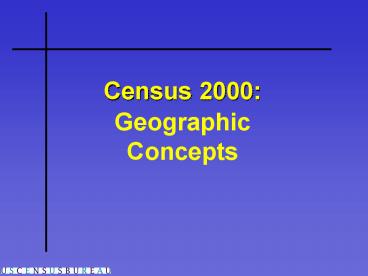Census 2000: - PowerPoint PPT Presentation
1 / 29
Title:
Census 2000:
Description:
To address difficulties in mapping USPS ZIP Codes. May represent either a five or three-digit USPS ZIP Code. How ZIP Code Tabulation Areas Are Created ... – PowerPoint PPT presentation
Number of Views:43
Avg rating:3.0/5.0
Title: Census 2000:
1
Census 2000 Geographic Concepts
2
Small-Area Geography Overview
3
Blocks
- Smallest units of data tabulation
- Cover the entire nation
- Do not cross census tracts or counties
- Generally bounded by visible features and legal
boundaries - Block numbers completely different from 1990
- Size average about 100 people
4
Census Block Map
5
Block Groups
- Groups of blocks sharing the same first digit
- Smallest areas for which sample data available
- Size optimally 1,500 people, range between 300
to 3,000
6
Census Tracts
- For the first time for Census 2000 Cover the
nation - Relatively homogenous population characteristics
- 65,000 Census tracts across U.S.
- Size optimally 4,000 people, range between 1,000
and 8,000
7
Block Groups and Census Tracts
8
Places
- Incorporated Places
- Census Designated Places
9
Minor Civil Divisions (MCD) orCensus County
Divisions (CCD)
- Used to establish and maintain a set of subcounty
units that have stable boundaries and
recognizable names - Do NOT have to follow minimum or maximum
population guidelines
10
Minor Civil Division / Census County
Division Map
11
Counties
- Counties in 48 States
- Independent Cities in 4 States
- Parishes in Louisiana
- Cities and Boroughs in Alaska
12
Counties
- Counties in 48 States
- Independent Cities in 4 States
- Parishes in Louisiana
- Cities and Boroughs in Alaska
13
Large Geographic Areas
- U.S. - Metropolitan Areas
- Regions - Urbanized Areas
- Divisions - American Indian
Reservations - States - Alaska Native Areas
- Hawaiian Home Land Areas
14
Census Regions and Divisions of the United States
15
Metropolitan Areas
- Defined by the Office of Management and Budget
(OMB) - Made up of a county or counties (or equivalent
entities) - Contain large population nucleus
- High socioeconomic integration
16
Metropolitan Area Three Types
- Metropolitan Statistical Area (MSA) One city
with 50,000 or more inhabitants or a
Census-defined urbanized area and a total
metropolitan population of at least 100,000
(75,000 in New England) - Consolidated Metropolitan Statistical Area
(CMSA) Meets MSA standards and population 1
million, separate standard-meeting components can
be identified, and local opinion supports
component areas - Primary Metropolitan Statistical Area (PMSA)
Components that make up a CMSA
17
Metropolitan Area Map
18
Urbanized Areas
- Densely settled areas with population of at least
50,000 - Geographic core of block groups or blocks that
have a population density of at least 1,000
people per square mile - Standards currently under review
- www.census.gov/geo/www/ua/ua_2k.html
19
American Indian Areas
- Tribal block groups
- Tribal census tracts
- Tribal designated statistical area
- Reservations
20
Alaska Native Areas/Hawaiian Home Land Areas
- 12 Alaska Native Regional Corporations - cover
the state - Alaska Native Village Statistical Area (ANVSA)
- Hawaiian Home Lands
21
American Indian Area/Alaska Native Area/Hawaiian
Home Land Hierarchy
22
Special Geographic Areas
- Zip Code Tabulation Area (ZCTA)
- Congressional Districts
- Public Use Microdata Area (PUMA)
23
ZIP Code Tabulation Areas (ZCTAs)
- Approximate area representations of USPS ZIP Code
service areas - Based on Census 2000 blocks
- To address difficulties in mapping USPS ZIP Codes
- May represent either a five or three-digit USPS
ZIP Code
24
How ZIP Code Tabulation Areas Are Created
Determine the majority ZIP Code for each census
block with addresses.
25
Public Use Microdata Areas (PUMAs)
- Geographic entity for extracts of raw data from a
small sample of confidentiality-screened,
long-form census records - Minimum population of 100,000, cannot cross a
state line (5-percent long-form records sample) - Super PUMAs - Aggregated PUMAs with a minimum
population of 400,000 (1-percent sample in a
national file)
26
Geographic Hierarchy
27
Hierarchy - Summary File 1 State FileSummary
Levels
- State
- County
- Place (or place part)
- Census tract
- Block group
- Block
- State portion of American Indian and Alaska
Native Area (with trust lands and with no trust
lands) and Hawaiian home land
28
Unique Geographic Identifiers
- Federal Information Processing Standards (FIPS)
Codes - Area Name 2000 FIPS
- State North Carolina 37
- County Transylvania 175
- Place Wilmington 74440
29
Questions/Feedback
- E-mail geography_at_census.gov
- URL www.census.gov
- General Questions 301-457-4100
- Geographic Questions 301-457-1128






























